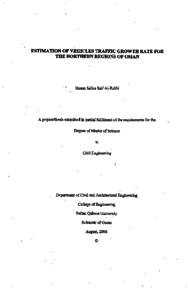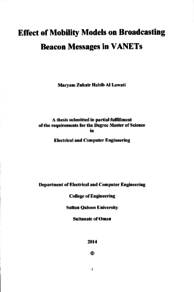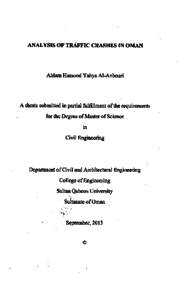وثيقة
Estimation of vehicles traffic growth rate for the northern regions of Omanز
الناشر
Sultan Qaboos University
ميلادي
2006
اللغة
العربية
الملخص الإنجليزي
Traffic growth rate (GR) is an essential input in the prediction of traffic volume, which is used in variety of applications such as highway geometric and pavement design and improvements,estimate of road revenue, selection of highway routes and estimating the time of maintenance. Three master plan studies for road network had been carried out in Oman. The first study was in 1985 by Jeep Peter Molar, The GR was estimated as 10% up to 1985, 8% up to 1990, and 6% after, 2000. The second one was in 1995 by Japan International Cooperation Agency (JICA). The annual GR was estimated as 9% after 1989. The last master plan study was in 2004 by JCA that focused on primary and secondary roads. The average annual GR of traffic was estimated 6.6% for the period of 1997-2002.
The objective of this study is to make coarse estimate of the annual growth rate through the use of historical traffic data for primary and secondary roads in four northern regions of Oman: Al-Batinah, Al-Dakhliyah, Al-Dhahirah and Al Sharqiyah, using linear and exponential regression analysis. The study also investigated the correlation of the traffic volume with socioeconomic variables: vehicles registration, fuel consumption, population and gross domestic product (GDP).
The historical traffic count data from 1978 to 2002 were gathered from Directorate General of Road (DGR) at the Ministry of Transport and Communication. The available data were all of short duration classification count that had been carried out manually. The data cover 175 count stations distributed all over Oman. However, only stations located in primary or secondary roads in the four targeted regions were selected for the analysis. Subsequently, the data for 43 counting stations were used in this study, Outliers in the data were removed using residual analysis. The population and socio-economical data were gathered from annual statistical manuals provided by the Ministry of National Economy.
The linear and exponential models revealed that Al-Sharqiyah has the highest GR of 8.0 and 9.9% using the linear and exponential models, respectively. The lowest GR was observed in Al-Dhahirah with values of 5.3% (linear) and 6.3% (exponential). Al-Batinah, Al-Dakhliyah and the overall northern region have almost similar GRs of approximately 7% (linear) and 8% (exponential). Although the linear and exponential models have not produced similar GR results, the cumulative traffic estimated by methods as the area under the curve is close to each other. The cumulated traffics estimated by the exponential and linear models were 87,628 and 87,533 vehicles, respectively for the period 1978 to 2000.
The GRş for the socioeconomic variables were estimated by the exponential model. The GR for vehicle registration was estimated as 7.8% for the period 1987 to 2000. The GR for population, fuel consumption (BBL) and GDP for the period 1993 to 2004 were estimated approximately as 2%, 5% and 5.4%, respectively. Comparatively, the GR for the ADT in the north is 7.9% using the exponential model. The increase in average daily traffic (ADT) in the northern region was found to correlate well (R=83%) with the increase in GDP of the Sultanate.
المجموعة
URL المصدر
قالب العنصر
الرسائل والأطروحات الجامعية



